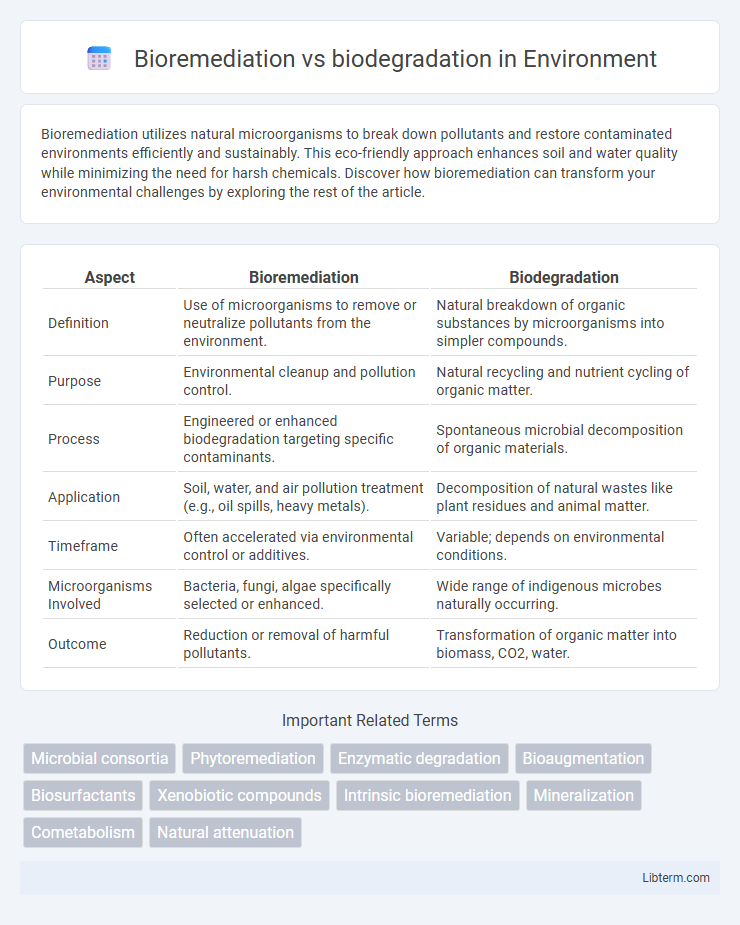Bioremediation utilizes natural microorganisms to break down pollutants and restore contaminated environments efficiently and sustainably. This eco-friendly approach enhances soil and water quality while minimizing the need for harsh chemicals. Discover how bioremediation can transform your environmental challenges by exploring the rest of the article.
Table of Comparison
| Aspect | Bioremediation | Biodegradation |
|---|---|---|
| Definition | Use of microorganisms to remove or neutralize pollutants from the environment. | Natural breakdown of organic substances by microorganisms into simpler compounds. |
| Purpose | Environmental cleanup and pollution control. | Natural recycling and nutrient cycling of organic matter. |
| Process | Engineered or enhanced biodegradation targeting specific contaminants. | Spontaneous microbial decomposition of organic materials. |
| Application | Soil, water, and air pollution treatment (e.g., oil spills, heavy metals). | Decomposition of natural wastes like plant residues and animal matter. |
| Timeframe | Often accelerated via environmental control or additives. | Variable; depends on environmental conditions. |
| Microorganisms Involved | Bacteria, fungi, algae specifically selected or enhanced. | Wide range of indigenous microbes naturally occurring. |
| Outcome | Reduction or removal of harmful pollutants. | Transformation of organic matter into biomass, CO2, water. |
Introduction to Bioremediation and Biodegradation
Bioremediation employs microorganisms, plants, or enzymes to detoxify and restore polluted environments by breaking down contaminants into less harmful substances. Biodegradation refers specifically to the natural microbial process where organic materials are decomposed into simpler compounds, serving as a critical mechanism within bioremediation strategies. Both processes play essential roles in environmental cleanup, with bioremediation encompassing targeted applications for pollution mitigation while biodegradation occurs as an inherent ecological function.
Defining Bioremediation: Scope and Applications
Bioremediation refers to the use of living organisms, primarily microorganisms, to detoxify or remove pollutants from soil, water, and air, making it a targeted environmental cleanup technology. Its scope encompasses the treatment of hazardous waste, oil spills, heavy metals, and pesticide contamination through natural or engineered processes. Applications of bioremediation include in situ treatment of contaminated groundwater, ex situ soil remediation, and enhancement of biodegradation pathways to accelerate pollutant breakdown.
Understanding Biodegradation: Mechanisms and Processes
Biodegradation involves the natural breakdown of organic substances by microorganisms such as bacteria, fungi, and algae through enzymatic reactions that convert complex compounds into simpler, non-toxic molecules. This microbial metabolism relies on environmental factors like temperature, pH, oxygen availability, and nutrient levels to optimize degradation rates and pathways, including aerobic and anaerobic processes. Understanding the specific biochemical pathways, such as hydrolysis, oxidation-reduction, and fermentation, is crucial for enhancing bioremediation strategies that leverage biodegradation for environmental cleanup.
Key Differences Between Bioremediation and Biodegradation
Bioremediation involves the deliberate use of microorganisms or plants to clean up contaminated environments, targeting pollutants like oil spills or heavy metals, whereas biodegradation is the natural breakdown of organic substances by microbial activity without human intervention. Bioremediation processes are often engineered and controlled to accelerate contaminant removal, while biodegradation occurs spontaneously and varies with environmental conditions. The primary distinction lies in bioremediation's applied technique for environmental restoration compared to biodegradation's inherent biological decomposition.
Microbial Roles in Bioremediation vs Biodegradation
Microbial roles in bioremediation involve the targeted use of specific microorganisms to detoxify and remove pollutants from contaminated environments, leveraging their metabolic pathways to transform hazardous substances into less harmful compounds. In biodegradation, indigenous microbial communities naturally break down organic materials, often without human intervention, through enzymatic processes that convert complex molecules into simpler forms. Both processes rely on microbial enzymes, but bioremediation strategically enhances microbial activity to accelerate pollutant removal, while biodegradation occurs as a natural environmental function.
Environmental Impact Assessment
Bioremediation utilizes microorganisms or plants to actively detoxify pollutants, making it a targeted approach with measurable environmental benefits, unlike natural biodegradation, which is a passive process of organic material breakdown. Environmental Impact Assessments (EIAs) emphasize bioremediation for its potential to reduce soil and water contamination more efficiently while minimizing secondary pollution and ecosystem disruption. Incorporating bioremediation strategies in EIAs supports sustainable remediation practices by enhancing pollutant removal rates and restoring ecological balance.
Practical Applications: Case Studies and Examples
Bioremediation involves using microorganisms or plants to detoxify polluted environments, with notable case studies including the Exxon Valdez oil spill cleanup in Alaska and the remediation of heavy metal-contaminated soils using hyperaccumulator plants. Biodegradation refers to the natural breakdown of organic substances by microbial activity, exemplified by composting organic waste and the decomposition of plastics in landfills. Practical applications of bioremediation emphasize engineered interventions to accelerate contaminant removal, while biodegradation often occurs passively without human facilitation.
Advantages and Limitations of Bioremediation
Bioremediation offers advantages such as cost-effectiveness, environmental sustainability, and the ability to treat a wide range of contaminants, including petroleum hydrocarbons, heavy metals, and pesticides. It utilizes natural microbial activity to degrade pollutants, minimizing ecological disturbance compared to physical or chemical methods. Limitations include the dependency on optimal environmental conditions like temperature, pH, and nutrient availability, which can slow down the process, and challenges in treating complex or high concentrations of contaminants efficiently.
Challenges in Biodegradation Processes
Biodegradation faces challenges such as incomplete breakdown of complex pollutants, leading to toxic intermediates that may persist in the environment. Microbial diversity limitations and environmental conditions like pH, temperature, and oxygen availability significantly impact the efficiency of biodegradation processes. These factors necessitate the optimization of microbial consortia and environmental parameters to enhance contaminant removal rates and reduce ecological risks.
Future Trends and Innovations in Environmental Remediation
Future trends in environmental remediation emphasize integrating bioremediation and biodegradation with advanced technologies such as synthetic biology and nanotechnology to enhance pollutant breakdown and accelerate soil and water recovery processes. Innovations include engineered microbial consortia designed for targeted contaminant removal and bioinformatics tools that optimize enzyme pathways for higher degradation efficiency. Combining these approaches promises more sustainable, cost-effective cleanup strategies addressing complex environmental pollutants.
Bioremediation Infographic

 libterm.com
libterm.com